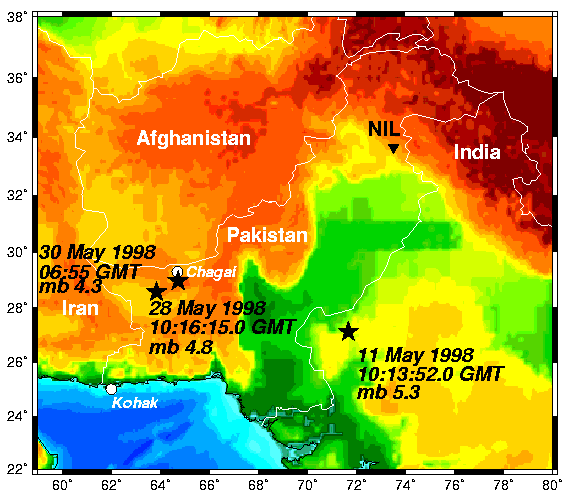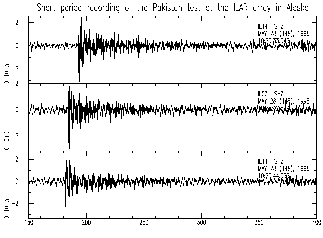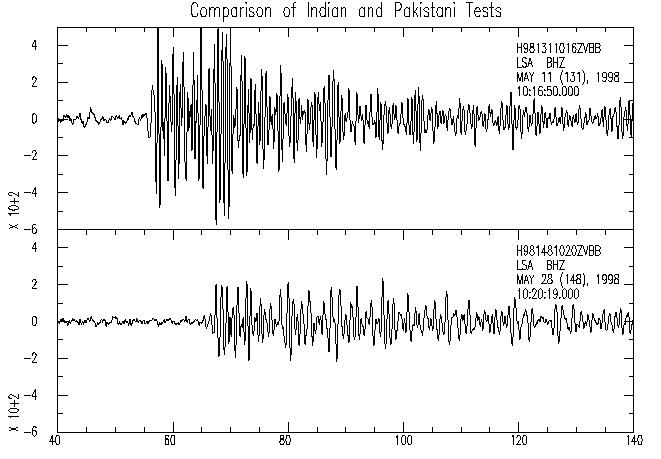Would you like to make this site your homepage? It's fast and easy...
Yes, Please make this my home page!
The May 1998 India and Pakistan
Nuclear Tests
This page replaces the earlier pages posted here which
provided information about the Indian and Pakistan nuclear tests in May, 1998.
If you would like to read a summary of a seismological analysis of the test
please follow this link: The
May 1998 India and Pakistan Nuclear Test, by Terry C. Wallace,
which will appear in the September issue of the Seismological Research Letters.
General Information
On May 11, 1998 the Indian government announced that they
had conducted a series of successful nuclear tests at their test facility in the
Rajasthan Desert. On May 13, the Indian government announced that it conducted
two further tests. The Pakistan government responded with a series of there own
tests. On May 28 the Pakistanis announced that they had exploded 5 nuclear
devices in the southwestern part of Pakistan. These tests were followed by
another test on May 30. The regional map below 
shows the location of the various tests.
Seismic Data
Seismic data is available from the IRIS
DMC, which collected all the "open" seismic data in near realtime.
Some of the world
wide recordings for the Indian explosion on May 11 from the IRIS GSN are
displayed here. Some of the IRIS
GSN recording for the May 28 Pakistan test are displayed here. If you are a
European viewer of this page the data is more easily accessed through ORFEUS.
The explosions were also recorded by the pIDC, which is
a prototype monitoring system for a Comprehensive Test Ban Treaty (CTBT). The pIDC
automatically detected and located the largest of the tests. Some of the PIDC
stations are within the US, including a shortperiod array in Alaska (ILAR). Even
thought ILAR is 83 degrees (more than 8500 km) from the Pakistan test site, it
still produced a nice shortperiod
seismic record for the May 28 test.
 The tests were well recorded by KNET
, an array of broadband seismic stations located in Kyrgyzstan, and operated
by Frank Vernon (IGPP, UCSD). The Institute for Geosciences and Natural
Resources (Hannover, Germany) in Germany operate the German Experimental Seismic
System (GERESS), a small aperture array. The GERESS
data provides an excellent constraint on the size of the Indian explosion.
The tests were well recorded by KNET
, an array of broadband seismic stations located in Kyrgyzstan, and operated
by Frank Vernon (IGPP, UCSD). The Institute for Geosciences and Natural
Resources (Hannover, Germany) in Germany operate the German Experimental Seismic
System (GERESS), a small aperture array. The GERESS
data provides an excellent constraint on the size of the Indian explosion.
Comparison of Events
The May 11 explosion was the largest (mb = 5.2), followed
by the May 28 (mb = 4.8) and May 30 (mb = 4.6) events. Shown below is a
comparison of the May 11 and May 28 events. It is obvious that the Pakistan
event

has a far more complex waveform. This has lead to
speculation that the of seconds. However, a comparison between May 28 and May 30
exlosions
casts doubt on this interpretation.
Related Topics
Seismic
Discrimination
- One of the principle problems for seismology in
nuclear monitoring is the discrimination of man made seismic events from
natural earthquakes.
Seismic
Yield Estimates
- There are several ways to calculate the explosive
yield from nuclear explosions from seismic signals. There are two main
factors effecting the yield/seismology relationships: emplacement conditions
(coupling) and seismic attenuation, especially in the upper mantle.
Links
Other information about the Pakistan nuclear
weapons program:
A
status review of Pakistan's program
- by Andrew Koch and Jennifer Topping including a
map of facilities.
A
review of Pakistan's nuclear weapons and weapon delivery systems
- by Ted Flaherty of the Center for Defense
information.
Other information about the Indian nuclear
weapons program:
satellite
images of the India test site.
- Vipin Gupta and Frank Pabian (Sandia Lab)
This page is maintained and updated by the SASO group
at the University of Arizona. It is not an offical government document, and
links to other pages are provided for information only. Contact is Terry
Wallace at wallace@geo.arizona.edu


